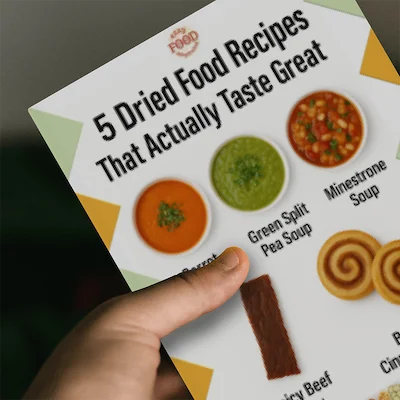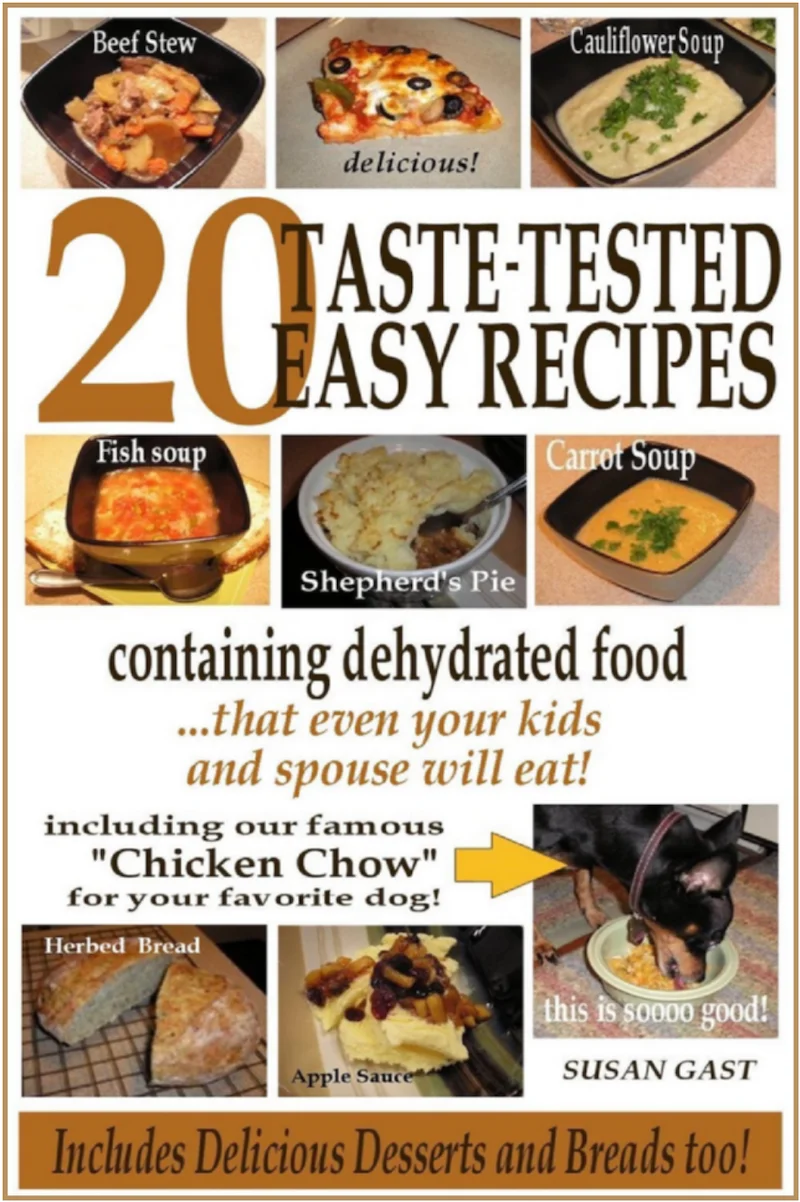What We Mean by “Dehydrate”
Here at Easy Food Dehydrating, “dehydrate” always means using an electric food dehydrator — the easy, reliable way to dry food at home.
- Home
- Easy Dehydrated Food Recipes
- Ratatouille with Dehydrated Vegetables
Ratatouille with Dehydrated Vegetables:
A Classic French Dish!

Ratatouille with dehydrated vegetables is a smart way to enjoy this classic French dish year-round, even when fresh produce isn’t available. It’s colorful, hearty, and full of flavor — proving that your pantry staples can create a meal that feels straight out of the Mediterranean.
✅ Quick Answer: How do you make ratatouille with dehydrated vegetables?
To make ratatouille with dehydrated vegetables, rehydrate zucchini, onions, mushrooms, and garlic in hot water, then sauté with eggplant, tomatoes, olives, herbs, and stock. Simmer until tender and serve warm with rice or orzo.
Packed with colorful zucchini, onions, mushrooms, and eggplant, this hearty recipe transforms pantry staples into a warm, comforting meal. Serve it on its own, or with rice or orzo for extra satisfaction.
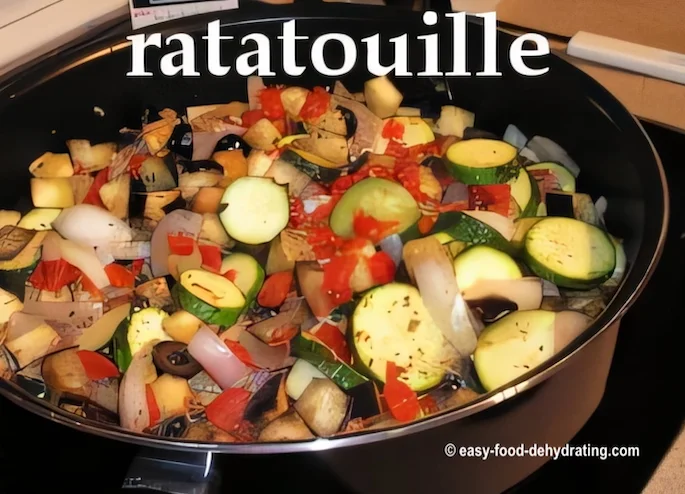
Whether you say rat-a-too-eee or ra-ta-twee—one thing’s for sure: this dish is pure veggie goodness! Plus, just look at those colors…
Guaranteed to make your kitchen smell like a vacation in Europe!

Ratatouille with Dehydrated Vegetables Recipe
Ingredients
-
1-1/2 cups dehydrated zucchini (or yellow squash—or combo!)
- 1/2 cup dehydrated onion rings
- 1/4 cup dehydrated mushrooms
-
3 slices dehydrated elephant garlic, crumbled
- 1 whole fresh eggplant, cubed (I leave the skin on, so wash well first)
- 10 extra large black olives cut in half
- boiling water (for dehydrated items)
-
2 tablespoons olive oil
- salt* and pepper to taste
- 1 14.5 oz. can small-diced tomatoes
- 1 cup of vegetable stock
-
1 tablespoon dried Italian Herb blend (more or less, to taste)
NOTE: Optional Orzo, 1 cup
Instructions
- Use the freshly boiled water to rehydrate the dehydrated items above. Let sit until they have plumped up.
- Heat olive oil in a large saucepan, and sauté the eggplant.
- Pour off excess water from dehydrated veggies and add the veggies carefully to your saucepan as water can spit in hot oil.
- Add 1 cup of vegetable stock and add the Italian seasoning.
- Add the sliced olives.
- Add the mushrooms.
- Cook for 15 minutes or until the vegetables are tender.
- If adding the orzo, add it in at step 4. You may need to add a little more boiled water too, if you find the orzo drinks up your stock too fast. Orzo only needs around 10 minutes to cook—half the time of rice. Adding rice (or orzo), to me, makes this Ratatouille dish like a risotto!
*IF you need to add salt, do so, BUT be careful NOT to over-salt as the bouillon has salt in it.
Nutrition Information
- Servings: 8 servings
- Calories: 100kcals per serving
- Fat: 4.7g
- Protein: 3.5g
- Carbohydrates: 13.5g
Nutrition Information with Orzo
- Servings: 8 servings
- Calories: 196kcal per serving
- Fat: 5.3g
- Protein: 6.3g
- Carbohydrates: 35.1g

Fantastic Colorful Spatula Set...
I use this silicone spatula set... All. The. Time.
Great buy over at Amazon.
They have other colors too such as turquoise, grey, black, blue, purple, and a multicolored set!
As an Amazon Associate, I earn commission from qualifying purchases. The price you pay does not increase. Read disclosure here.
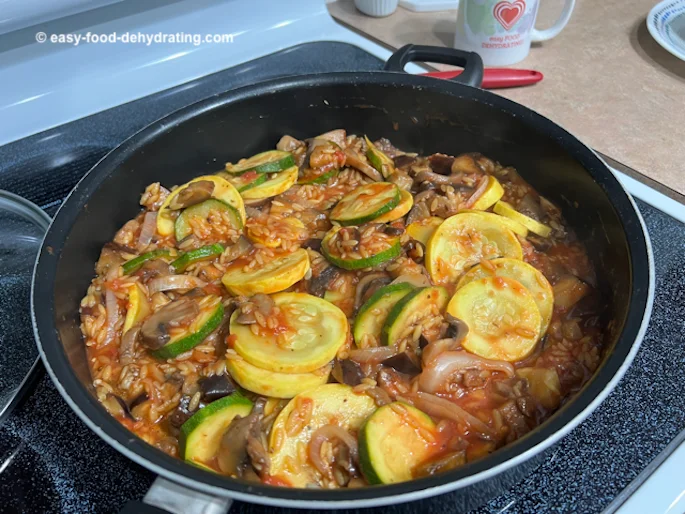 Ratatouille WITH ORZO, ready to eat!
Ratatouille WITH ORZO, ready to eat!Fresh Ingredient Swaps (If You Have Them)
If you want to use fresh ingredients that you may have on hand, do this:
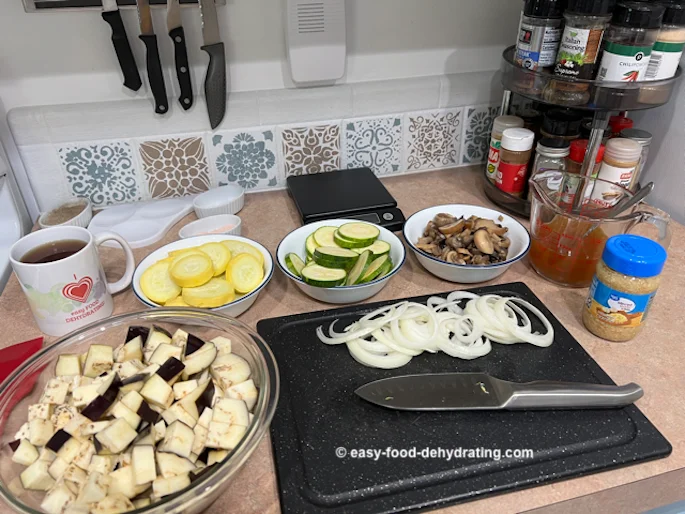
Exchange the dry ingredients in the recipe, above, for these fresh ingredients listed below!
- 2 large yellow squash or green zucchini (or one of each as a combo!) washed, peeled, and sliced
- 1/2 large onion, peeled and diced
- 1 cup fresh sliced mushrooms
- 3 slices fresh elephant garlic, or 1 and 1/2 small cloves of "regular sized" garlic
Note from my hubby: "Will you cut the squash in smaller pieces next time?"
My answer: Nope. (Being awkward)
Hubby: "Can you add paprika and rosemary?"
Answer: Yep. (Being accommodating)
He also loves this ratatouille with grated cheddar cheese on top! Typical cheesy-guy thing...
NOTE: If you're adding orzo, keep an eye on the pan. Even though my saucepan is nonstick, make sure to turn the heat down low and stir/scrape the bottom while turning over the ingredients with a soft silicone spatula.
Add a dash of water if the ratatouille seems dry.
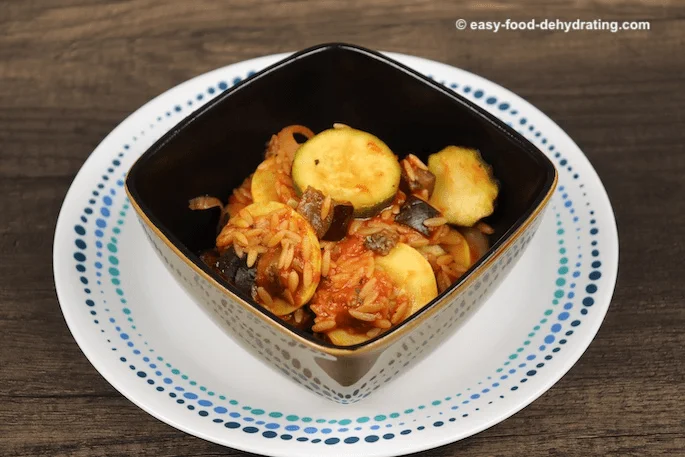 Ratatouille with Orzo... yummy!
Ratatouille with Orzo... yummy!20 Taste-Tested Easy Recipes
🍕 Pizza! 🥧 Shepherd's Pie! 🥘 Beef Stew! plus
Cauliflower Soup and Cauliflower Mash, along with crazy Carrot Soup!
Decadent Desserts: Carrot Cake and Cranberry Pineapple Pie!
and more...
Fresh food ingredient amounts are included for when you have fresh food on hand.
See which recipes are included here.
As an alternative to the orzo, make some white or brown rice to serve with these vegetables.
This dish smells so good when it is cooking; it fills your kitchen with a very pleasant aroma of the Mediterranean!
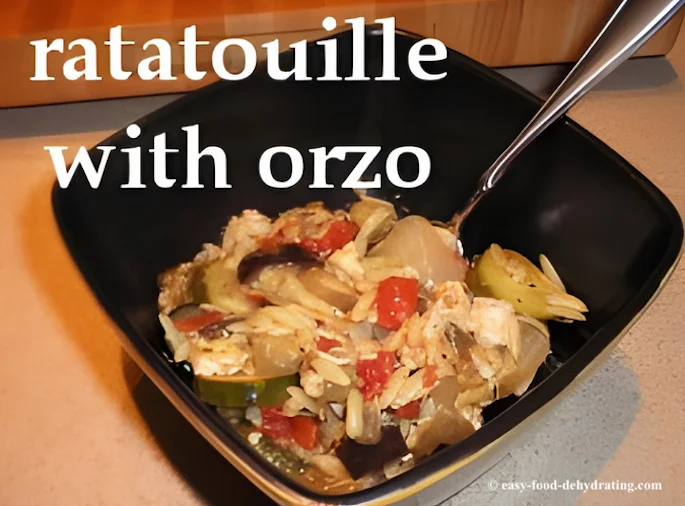
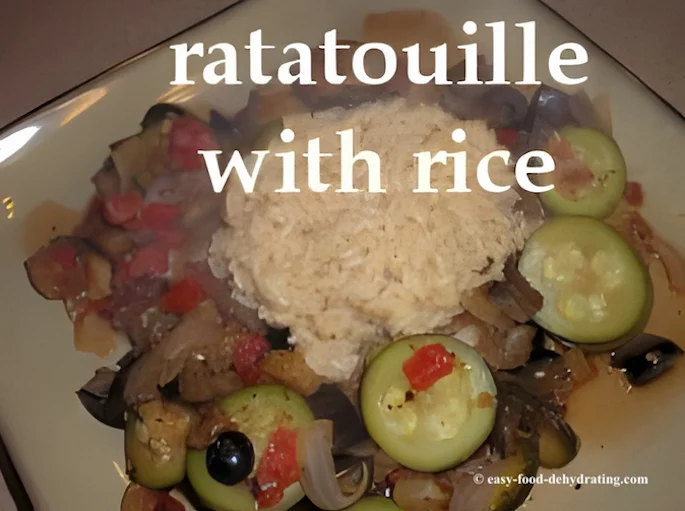
Use the ratatouille as a vegetable side dish, but with the addition of rice or orzo, it makes a complete meal.
When you've got leftover rice, remember to save it to make Ratatouille with Rice.
If You're Wondering, "What is Orzo?" - Keep Reading!
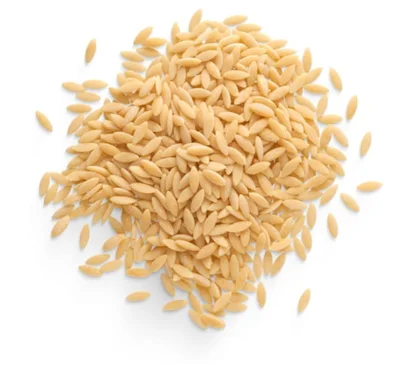 ORZO: looks yellow and is 'fatter and flatter'
ORZO: looks yellow and is 'fatter and flatter'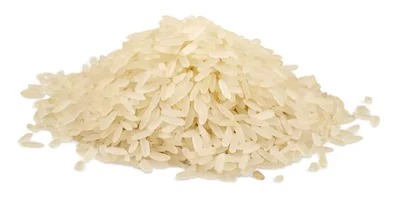 RICE by comparison: is whiter, and looks 'slimmer'
RICE by comparison: is whiter, and looks 'slimmer'NOTE: Orzo is a type of pasta that is shaped like a large grain of rice.
Key Facts About Orzo:
- The name orzo comes from the Italian word for "barley," as it closely resembles a barley grain.
- Traditionally made from semolina or durum wheat, it has a chewy, slightly nutty flavor similar to rice or barley.
- Orzo is widely used in Mediterranean cuisine, especially in Italy, Turkey, and Greece.
- The most common size is about 3mm in diameter, but it can range from 2mm to 5mm in size.
- It’s a versatile ingredient, perfect for soups, salads, casseroles, stir-fries, and side dishes.
How to Cook Orzo:
- Bring a pot of lightly salted water to a boil.
- Add the orzo and cook for 7-9 minutes until al dente.
- Drain and rinse in a colander, then serve as desired—plain, with a drizzle of olive oil, or mixed into dishes.
- Cooking ratio: Use 1 cup of dry orzo to 4 cups of water or broth, seasoning to taste.
- For extra flavor, cook orzo in broth, tomato sauce, or infused with herbs for a more aromatic dish.
Why Orzo Cooks Faster than Rice
'The reason why orzo cooks faster than rice is because orzo is actually a type of pasta, while rice is its own separate grain.
Some key differences that cause the cooking time variance:
- Pasta is made from wheat flour while rice is made from rice grains.
- The wheat flour in pasta contains gluten, which gives it a chewy texture. Rice does not contain gluten.
- Pasta is made with semolina or durum wheat flour which is coarser than all-purpose flour. This coarser flour helps pasta retain its shape better.
- Rice has a higher starch content which requires more time to gelatinize and soften during cooking.
- Pasta is dried during production which removes more moisture allowing it to cook quicker (than rice). Rice still contains its original moisture.
FAQs About Making Ratatouille with Dehydrated Vegetables
Can I use fresh vegetables instead of dehydrated in this ratatouille recipe?
Can I use fresh vegetables instead of dehydrated in this ratatouille recipe?
Yes, of course! If you have fresh zucchini, onions, mushrooms, and garlic on hand, simply swap them in for the dehydrated versions. Cooking time may be shorter, since fresh vegetables don’t require rehydration.
Do I need to rehydrate the vegetables before cooking?
Do I need to rehydrate the vegetables before cooking?
Yes, rehydrating ensures the veggies cook evenly and absorb flavors. Let them sit in hot water 10–15 minutes, then drain before adding to the pan.
How can I store leftover ratatouille with dehydrated vegetables?
How can I store leftover ratatouille with dehydrated vegetables?
Refrigerate leftovers in an airtight container for up to 4 days, or freeze in portions for up to 3 months.
Is ratatouille with dehydrated vegetables best eaten right away?
Is ratatouille with dehydrated vegetables best eaten right away?
Yes. This dish tastes best when enjoyed the same day, while the vegetables are still firm and colorful. Leftovers can be stored and reheated, but the texture may become softer than when freshly made.
Thanks for visiting my ratatouille with dehydrated vegetables page! This colorful, flavor-packed dish shows how easy it is to turn dehydrated ingredients into a satisfying Mediterranean meal.
If you’d like more inspiration, pick up a copy of my free 5 Dried Food Recipes You’ll Actually Love PDF below — including carrot soup, minestrone soup, split pea soup, spicy beef jerky, and banana cinnamon rolls. They’re pantry-friendly favorites your family will love.
Get 5 Dried Food Recipes You'll Actually Love
Here's where you can get your copy of our all new
5 Dried Food Recipes (That Actually Taste Great)
They're my all-time favorite easy dried food meals!
Get it here right now.
For Free!
Before You Go...
If you enjoyed this page, tap the ❤️ in the lower right-hand corner.
It saves this page to your Grow bookmarks so you can find it again later.
You’ll also see quick share buttons to copy the link, post to Facebook,
or save it straight to Pinterest.



